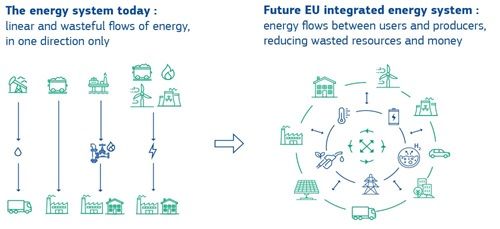- within Criminal Law topic(s)
In Short
The Situation: The European Commission ("EC") recently unveiled its dual strategy plans to transform Europe's energy system. The European Union's ("EU") Energy System Integration Strategy and Hydrogen Strategy aim at a fully decarbonized, more efficient, and interconnected energy system.
The Context: These strategies were adopted against the twin background of the European Green Deal (toward boosting efficient use of resources by moving to a clean, circular economy and halting climate change) and the Next Generation EU plan (toward fostering EU recovery from the COVID-19 pandemic).
Looking Ahead: Europe aspires to become the first climate neutral continent by 2050 through deep decarbonization of all sectors of the economy and greater reductions in greenhouse gas emission by 2030, while promoting job growth and green technology.
Background
At the close of 2019, the EC challenged itself to address the grave global threat of climate change and environmental degradation. As 2020 unfolded, COVID-19 brought yet another acute crisis.
Toward combating this dual threat, the EC is pursuing a key common solution. A transformed energy sector is anticipated to play a vital role in achieving environmental goals and rebuilding Europe in the aftermath of the COVID-19 crisis, as advocated in the EC's recently adopted Next Generation EU recovery plan.
The EC believes that a better-integrated energy system will be crucial to delivering on climate change targets, while generating jobs and strengthening innovation in the EU to retain global industrial leadership in clean energy technology. By 2050, the EC envisions an EU reshaped into a modern, resource-efficient, and competitive economy with no net emissions of greenhouse gases.
Against this backdrop, in July 2020, the EC adopted the European Strategy for Energy System Integration and the Hydrogen Strategy for a Climate Neutral Europe. Each Strategy is set out as an EC Communication. (While nonbinding, the EC uses Communications as key instruments to identify problems in policy areas and to set out the direction of future policies.)
The European Strategy for Energy System Integration
Over the past decade, renewable power generation has gained momentum in many European countries. Belgium, for instance, is now the world's fourth largest producer of offshore wind energy after reaching an installed capacity of 1,775 MW with the commissioning of the Northwester 2 wind farm. The EC recognizes, however, that creating renewables is not enough. An entirely new energy system is needed.
Europe's current energy system is based on a model of separate silos (parallel and vertical energy value chains), which rigidly link specific energy resources with specific end-use sectors. The EC cites the example of petroleum products, predominantly used in the transport sector and as feedstock for industry. By contrast, coal and natural gas are mainly used to produce electricity and heating.
The silo model cannot achieve a climate neutral economy. Instead, an energy system must be planned and operated as a combined whole, across multiple energy carriers, infrastructures, and consumption sectors. As illustrated by the EC:

An integrated European energy system should reflect the following characteristics: (i) a more circular system that consumes less resources and with no wasted energy. Energy efficiency should be a key priority; (ii) a greater focus on direct electrification of the largest possible number of end-use sectors. The use of cleaner electricity produced from renewable sources should grow and extend into more areas; and (iii) where electrification is difficult, costly, or impossible in certain sectors, clean gases and fuels should be promoted (such as clean hydrogen and sustainable biofuels and biogas).
The EC presents an extensive list of measures toward attaining an integrated energy system as swiftly as possible. This includes revamping existing energy legislation, activating financial support and research, and deploying new technologies and digital tools.
The Hydrogen Strategy for a Climate Neutral Europe
The EC places a priority on developing clean hydrogen produced from wind and solar energy. The EC recognizes the versatility of hydrogen, which can be used as feedstock, fuel, or as an energy carrier and storage holder (for instance, to balance variable renewable energy flows), with diverse applications across industry, transport, power, and buildings sectors. As such, hydrogen can play a key role in an integrated energy system and in power sectors where electrification is not feasible.
The Hydrogen Strategy for a Climate Neutral Europe sets forth a gradual approach to boosting both supply and demand. Starting from today's very low presence of clean hydrogen, the EC aims at reaching 10 million tons by 2030. By 2030-2050, renewable hydrogen technologies should reach maturity and large-scale deployment across all "hard-to-decarbonize" sectors.
To support the EC in reaching these goals, the European Clean Hydrogen Alliance was launched. This forum will gather industry leaders, civil society, and national and regional government bodies working together with the European Investment Bank. This Alliance is tasked with creating an investment pipeline for scaled-up production of renewable hydrogen and responding to demand for clean hydrogen in the EU.
Four Key Takeaways
- Europe's energy system is at a turning point, faced with environmental threats and even greater urgency for change with COVID-19's economic upheaval. Initial steps toward decarbonizing the economy, while important beginnings, are far from leading Europe to climate neutrality by 2050.
- The EC's Energy System Integration Strategy provides a framework for Europe's green energy transition and introduces a new model: the coordinated planning and operation of Europe's energy system as a whole, across multiple energy carriers, infrastructures, and consumption sectors.
- The EC's Hydrogen Strategy for a Climate Neutral Europe will spur the supply and demand of clean hydrogen throughout the European economy. Investments in clean hydrogen, and the creation of sustainable growth and jobs, will play an essential role in Europe's recovery from the COVID-19 crisis.
- Energy policies and regulation will continue to evolve and play a critical role in reaching the EU's green economy goals. Developers, funders, and investors in renewable energy and renewable hydrogen, in particular, must keep pace with this shifting terrain.
The content of this article is intended to provide a general guide to the subject matter. Specialist advice should be sought about your specific circumstances.




